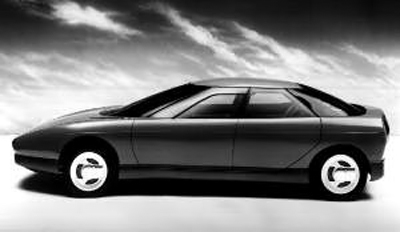Activa29 September 1988 saw the announcement of Activa at the Paris Motor Show. |
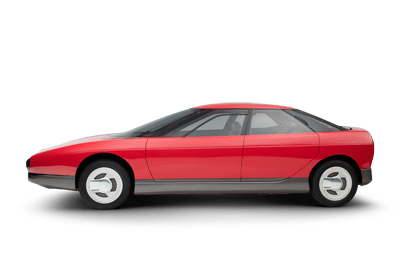 |
 |
|
|
The Activa programme saw the development of four wheel drive and four wheel steer allied to an active suspension system all housed in an extremely elegant and aerodynamic body. Much of the suspension technology would appear the following year in the Hydractive-equipped XM :- the marriage of CitroŽn's tried and trusty high pressure hydraulics with state of the art electronics to offer an unrivalled combination of comfort, safety, road holding and handling. |
|
|
|
 |
 |
 |
 |
|
 |
 |
 |
 |
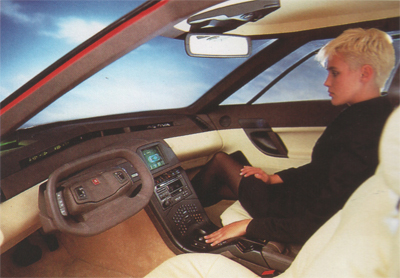 |
 |
 |
 |
 |
 |
|
These monochrome photos are courtesy of Dan Abramson who was responsible for Activa's body design. Click on each image to see a larger version which will open in a new window. Dan writes, "All projects were photographed by the in house photographer at each presentation to the Direction. We had a safe at Vťlizy where the photos (copies) were stored and you had to sign out to use the photos. All originals were kept at the photo service PSA at La Garenne. Eventually CitroŽn got its own photo service but not until rather recently with the regroupment of design at the ADN. The show cars were treated differently and we had "special" authorisation to take our own photos. We went all out on the Activa 1 with boxes of photos. Roughly 100 engineers worked on the project at one time or another and was the only real concept car ever done by CitroŽn (all out technical tour de force)." |
|
 |
 |
| Click image below for large
version |
|
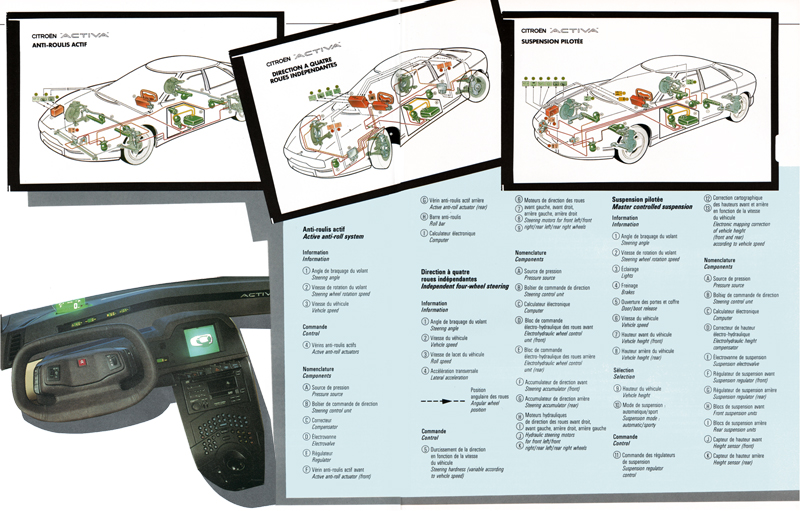 |
|
|
LABORATORY PROTOTYPE FOR THE 1988 MONDIAL DE LíAUTOMOBILE For the 1988 Mondial de líAutomobile (Paris Motor Show) CitroŽn has taken up the challenge of combining hydraulics and electronics to produce Activa, the new laboratory prototype vehicle, in which all hydraulic systems are electronically controlled.
CitroŽn has already gone down in automobile history with its innovative hydropneumatic suspension and of course the Traction Avant. Today, CitroŽnís engineers have integrated hydraulics technology into the suspension, steering and braking systems. With its unequalled technological capital in the field, CitroŽn has gone further than anyone else in optimizing hydraulic systems. The marque has further underlined its position as the world leader in roadholding and ride comfort technology. The famous CitroŽn suspension system has three main components: a constant mass of compressible nitrogen gas enclosed in a sphere, with one sphere per wheel, which replaces the conventional mechanical springs, a mineral hydraulic liquid, separated from the gas by a flexible diaphragm, and a hydraulic control unit that maintains the liquid at high pressure. When driving over bumps in the road, the gas in the sphere is compressed and the resulting free space is filled by the liquid. When driving over holes in the road, the gas expands and forces the liquid out of the sphere. Not only does the hydropneumatic suspension offer greater elasticity, but it also adapts itself to the vehicle load. The bodywork remains level and at the same ride height, irrespective of the load and load distribution.
The use of electronics has now raised the hydropneumatic suspension system to new heights of reliability and efficiency. Instant vehicle self-levelling is achieved by integrating new, subtle parameters such as vehicle speed, wheel reaction and steering angle, which are used to correct flexibility, damping and roll. All the movements of a conventional vehicle are minimized, or even eliminated. The suspension works on the basis of flexible response and an instantly variable damping system. Each axle has several suspension spheres that are controlled by data (vertical bodywork movement, angle of steering wheel and vehicle speed) picked by sensors and sent to a computer. As the vehicle speed increases, the suspension stiffens. The driver can use the dashboard controls to pre-select a stiff suspension configuration for a sporty ride whenever he chooses. As speed increases, the trim (or position of the bodywork in relation to the ground) is changed for an improved Cd. At the same time, the vehicle is kept level by an electrohydraulic ride height control that integrates electronic mapping and is connected to sensors. Vehicle height can be changed by the parameters recorded in the electronic mapping system. For example, when at a standstill, the electrohydraulic ride height control raises the vehicle by four centimeters so that it makes it easier for passengers to get in and out. The power-assisted suspension also corrects dynamic shifts in lateral loads. Roll is compensated by an active anti-roll system made up of hydraulic actuators on the front and rear anti-roll bars. The computer, which is permanently informed of the steering wheel angle and vehicle speed, commands the electrohydraulic governor, linked up to a roll detector, to regulate the pressure in the actuators. The vehicle can therefore corner on the level, irrespective of vehicle speed and the sharpness of the bend.
The Activa features four-wheel drive for extra-safe handling, four-wheel steering and, more spectacular stillā all-round independent wheel movement. The independent movement of the front and rear wheels allows the car to turn a complete circle with a diameter of just nine meters and gives CitroŽn a competitive edge over other systems in which the rear wheel steering is slaved to the angle of the front wheels. The ideal solution for those tight bumper-to-bumper parking problems. Built for the future and integrating the components and techniques used in the aeronautics industry, the Activa heralds a new era of ďdrive-by-wireĒ technology: the mechanical links between the steering system and the wheels have been entirely replaced by tubes filled with hydraulic fluid and electric wiring. To create this ďanti-mechanicalĒ miracle, an entirely new system had to be thought out and designed. A computer uses four motors linked to the hydraulic control unit to calculate the optimum steering angle for each wheel according to vehicle speed, steering wheel angle and other parameters. This experimental system both eliminates all the common minor faults of a conventional steering system and provides a testbench to rewrite the steering angle laws and explore the full potential of four-wheel steering vehicles. A hydromechanical backup system is activated in the event of a malfunction in the electronic circuitry. Activa is also fitted with anti-block and anti-skid brakes.
The same attention to comfort is evident in the electronic data displays inside the vehicle. The all-leather interior is tastefully decked out in grey and beige. Continuous glazing provides excellent all-round visibility. The smooth dashboard is striking in its discreet simplicity. The variable reduction steering system limits the turning radius of the innovative and effectively rectangular steering wheel to 60 degrees in either direction. Power assistance varies accord-to the speed of the car, therefore avoiding wide steering angles at high speed. Holographics technology enables the driver to monitor speed and engine revs in an eye-level mirror located at the base of the windscreen. Other performance data such as oil pressure, water temperature, or remaining petrol appear just above the steering wheel on a display strip that extends across the passenger side. The easy-to-read display is therefore visible to both the driver and his travelling companion. Safety and ride comfort data (car status, doors open, steering angle of rear wheels, air conditioning, etc.) appear on a liquid crystal display at the top of the sunken console that separates the driverís seat from the front passenger seat. This screen also displays data from the eight proximity detectors located in the bumpers that give the driver advanced warning of any scrapes or near-misses when in a tight spot. This screen also displays data from the eight proximity detectors located in the bumpers. Additional features such as a radiotelephone and a teletex terminal with customized communications card for use by all passengers, mean that Activa is a user-friendly interface with the outside world. The floppy disk drive is installed within easy reach of the driver to read various programs such town plans, road maps, route displays. etc. The main upright between the remote control doors has been done away with. The doors open in opposite directions, providing easy access to the interior. The position of the electronically controlled rear wing changes in line with speed. The conventional front lights have been replaced by a thin continuous plexiglass strip that houses two small lamps surrounded by a complex arrangement of mirrors. The rear brake lights are made up of broad strips that extend across the complete width of the vehicle, while the vehicleís roof is no bigger than an umbrella. Activa is not just for show. And this four-door saloon research vehicle is not just an example of design for design's sake. It provides CitroŽn and the PSA Group with the opportunity to unveil the activities of its Research and Development Department at Vťlizy, where design engineers and technicians strive to optimize the age-old trade-off between vehicle behaviour and passenger comfort and to create the vehicle that will cater for tomorrow's needs.
|
|
|
|
|
 |
 |
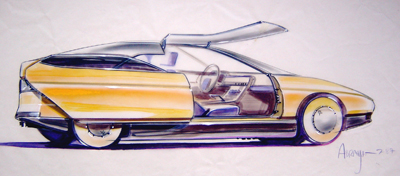 |
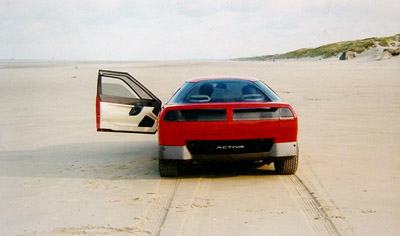 |
|
Above Dan Abramson's proposal for combination gull wing and sliding doors - in the event the show car had conventional front doors and rear-hinged rear doors - right |
|
 |
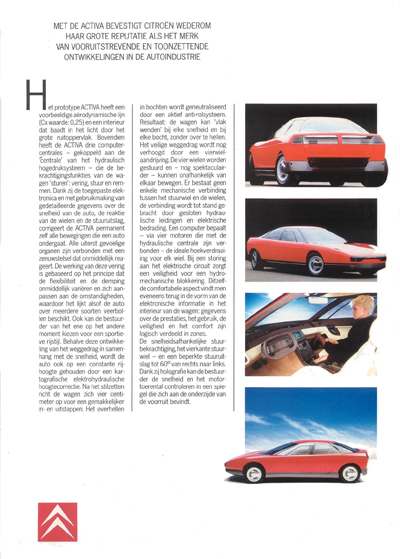 |
 |
|
 |
|
 |
|
 |
|
 |
|
|
Above Art Blakeslee pictured with show cars all penned by Dan Abramson apart from Eco 2000 which was by Scott Yu Left to right: Eco 2000 - Xanae - Berlingo Bulle - Activa - Activa 2 |
|
| © 2000/2013 CitroŽnŽt, 2010/2011 Dan Abramson
and 1988 le Double Chevron |
|


